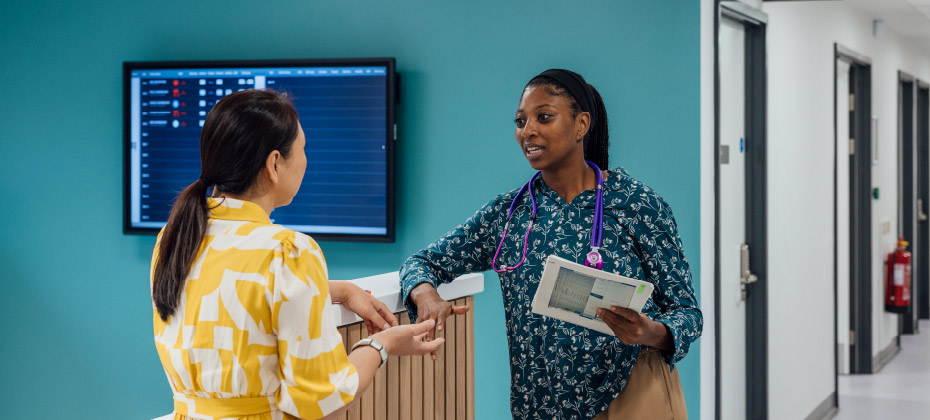Tag: state of patient access

While the healthcare industry remains hesitant about automation, there's one area where digital tools have already proven their worth: patient intake. According to Experian Health's State of Patient Access survey, almost 90% of patients say they welcome digital patient registration, reflecting the growing demand for efficiency and convenience. Staff frustration with mounting paperwork and poorly coordinated manual systems also points to an urgent need for a better way of working. The case for switching from traditional to digital patient intake systems is pretty compelling, even before factoring in potential cost savings. For providers still taking a “wait-and-see” approach, it may be worth considering how digital patient intake could address some of the most common challenges associated with traditional registration methods, such as the following: 1. Online registration can prevent missed opportunities for patient bookings Patients' number one patient access challenge is seeing their doctor quickly. Too many are stopped in their tracks by slow and inflexible intake processes. Inconvenient booking protocols – often requiring phone calls during limited office hours – deter patents, resulting in sluggish scheduling rates and avoidable gaps in physician calendars. Moreover, traditional systems that treat scheduling and registration as two distinct activities miss the chance to accelerate intake because patients have to fill out the same information multiple times. Digital patient intake streamlines scheduling and registration so patients can book and manage appointments anytime, anywhere. With a mobile-first automated platform, patients can provide essential demographic and insurance information at the point of booking, and fill out remaining registration forms whenever it suits with a single click. When intake is easy, bookings increase. 2. Digital patient access can reduce high no-show rates Quick and convenient intake addresses the related challenge of no-shows, which lead to underutilization of services and delayed patient care. If canceling or rescheduling an appointment is easy, patients are more likely to make that little bit of effort to click the link instead of simply not turning up. With accurate patient data coming in at the start, providers can send automated appointment reminders and tailored messages to coordinate follow-ups, so patients are less likely to forget appointments or misremember referral instructions. 3. Digital patient intake can prevent payment delays and claim denials Inefficient registration means patient information passes through multiple hands, resulting in data entry errors that trickle through the revenue cycle. In a recent Q&A, Barb Terry, Product Manager for Registration Accelerator at Experian Health, talked about the importance of ensuring accurate data from the start: “Waiting until the patient's appointment to collect insurance information doesn’t give providers much time to verify insurance, or to determine the patient’s financial responsibility for copays, deductibles, and out-of-pocket expenses… In previous surveys, 40% of providers have said registration errors are a primary cause of denied claims. Obtaining patient registration data before the appointment helps to ensure revenue cycle processes flow efficiently to reduce denials and financial risks.” With Registration Accelerator, patients receive a text to scan their identity and insurance cards, validating the data in real-time and automatically uploading it into eCare NEXT®. Experian Health's Eligibility Verification and Registration QA tools can then use the same verified data, reducing the risk of manual errors that lead to claim denials. 4. Reduce patient stress caused by unclear costs One of the clearest messages from patients in this year's State of Patient Access survey is the need for upfront, transparent information about costs. A disappointing 64% of patients did not get price estimates before care, and of those that did 14% said their estimates were inaccurate. It's extremely challenging for staff to compile all the data points necessary to calculate patient responsibility using traditional systems. Digital tools that automate patient data capture, insurance eligibility verification, coverage discovery and prior authorizations provide financial clarity quickly and accurately, giving patients peace of mind and reducing the burden on staff. By improving the patient billing and payment experience, providers can reduce financial stress for patients and get paid more promptly. 5. Digital patient intake reduces high operational costs and poor use of staff time Traditional registration systems are full of hidden costs, from the hefty price tags associated with paper forms, storage and printing to the time required of admin staff. These expenses are compounded over time by revenue leakage caused by errors in claim submissions and scheduling delays. Staffing shortages mean many providers simply don't have the human power to handle these challenges using manual systems alone. Again, automation comes out on top. Registration Accelerator eliminates the need to scan, fax and file forms and automatically handles patient check-ins, form returns and demographic updates. It is one of a suite of tools that feed into eCare NEXT®, automating up to 80% of the pre-registration process. A digital helping hand for faster, smarter, more accurate patient intake As patient intake challenges continue to grow, digital patient intake stands out as a practical and proven solution to streamline access to care and stabilize cash flow. With Registration Accelerator, staff can focus on critical tasks that drive revenue and make a positive first impression on patients who are looking for a convenient and compassionate healthcare experience. Find out more about how Registration Accelerator expedites patient intake and solves the operational and financial challenges that come with traditional systems. Learn more Contact us

The State of Patient Access 2024 marks the fourth installment of a series of surveys initiated in 2020, comparing patient experiences and providers' perceptions of those experiences. Experian Health's latest infographic highlights findings from the latest survey, conducted in February 2024, involving 200 healthcare revenue cycle decision-makers and over 1,000 patients. The study reveals an overall improvement in perceptions of access to care, indicating a positive trend in providers' efforts. However, there are still significant challenges ahead. Providers continue to believe access is better than what patients actually experience, a consistent finding across surveys. Check out the highlights in the infographic: Despite progress, there's a clear need to bridge the gap between patient experience and provider perception. How can providers turn their perceptions into reality for patients? Download The State of Patient Access 2024 report to gain deeper insights into patients' and providers' perspectives on access to healthcare.

What do patients and providers really think about patient access services in 2024? Drawing insights from more than 1000 patients and 200 healthcare executives, Experian Health's fourth State of Patient Access survey pulls back the curtain. Previous surveys revealed a persistent gap between patient and provider perspectives on patient access, but could the gap finally be closing? The State of Patient Access 2024 report suggests that while discrepancies remain, the two groups appear closer than ever. This article provides a summary of the State of Patient Access 2024 report, and gives a run-down of patient and provider perspectives on patient access, what they see as top challenges, where opinions diverge and the steps providers can take to continue building a positive patient access experience in the year ahead. How do patients feel about patient access? 1. More patients think access has improved compared to last year 28% of patients believe patient access has improved over the last year, which is up from just 17% in 2023. As in previous years, patients' perception of whether access has improved hinges on how quickly they can see their doctor. Anything providers can do to accelerate scheduling and registration will be a winner. 2. Patients welcome the efficiency and accuracy of digital tools Patients have noticed improvements in scheduling and registration processes. They welcome the ability to book appointments anytime and avoid unnecessary paperwork using digital technology. That said, financial considerations trump convenience: the ability to look up insurance coverage and obtain accurate price estimates before care have risen to the top of the list of what patients consider the most important aspects to improve. 3. Cost of care remains a concern Unfortunately, patient sentiment around healthcare payments has remained relatively flat since 2022. Slightly more patients are receiving upfront cost estimates compared to previous years, but accuracy appears to have dropped, with 74% of patients reporting accurate estimates compared to 78% in 2023. Patients must have faith in their estimates if they are to plan for upcoming bills with confidence, and providers should be able to provide transparent and accurate payment estimates. What do providers think about patient access? 1. Providers are again more optimistic about improvements than patients Like patients, providers are generally positive about the state of patient access, though they may be a little too optimistic about the effect of improvement efforts. Around twice as many providers think access is better than the previous year compared to patients (55% compared to 28%). For providers, perceptions of improvements in patient access are closely tied to the impact of staffing levels. 2. Self-scheduling is back in favor Providers are aligned with patients on the need for digital scheduling and registration options. Interestingly, after the urgency to implement contactless scheduling during the pandemic began to wane in 2022, the latest survey suggests that self-scheduling is back in fashion, with 63% offering self-scheduling compared to 40% in 2022. 3. “Dirty data” remains a stubborn challenge Data collection at patient intake is a persistent headache for providers. Almost half (49%) say that inaccurate patient information contributes to claim denials. Improving the speed and accuracy of resolving patient information prior to claims submission were frequently listed in providers' top three challenges. See how healthcare organizations are using AI AdvantageTM to improve data accuracy and reduce claim denials. Digital technology bridges the gap between patient and provider perspectives on patient access When asked for their top three priorities for improvement, both groups ranked accurate price estimates and efficient insurance verification among their top two. While they diverge on the third – access to online health management tools for patients, and automated pre-authorizations for providers – it's interesting to note that these both reflect a desire to use digital solutions for greater efficiency and convenience. The survey highlights several opportunities to use digital technology to address upcoming challenges and continue to close the gap. Key challenges in patient access in the year ahead 1. Improving accuracy of upfront price estimates The survey showed 79% of providers plan to invest in patient access improvements soon. Given shared concerns about patients' ability to cover the cost of care, and worrying hints that some may postpone care due to cost concerns, prioritizing and providing accurate patient estimates would be a smart choice. While patients and providers are in closer agreement that estimates are accurate most or all of the time (74% and 85% respectively), there's clearly room for improvement. 2. Accelerating insurance verification and claims submission processes Several of the providers' top challenges speak to how difficult it can be to collate accurate information prior to claims submission. The need for better insurance reviews, more efficient management of prior authorizations, and more accurate patient information all contribute to the overarching goal of getting properly reimbursed. Almost a fifth say that managing multiple tools to determine eligibility, coordination of benefits (COB), and other pre-service checks is a top challenge. Could a single solution be the answer? Experian Health's new Patient Access Curator solution checks eligibility, COB, Medicare and commercial coverage, demographics and financial status in less than 30 seconds. Staff can check off several of these tedious tasks with just a single click. 3. Bolstering workforce capacity with technology A final challenge in the year ahead is the ongoing impact of staffing shortages. For the of providers who feel that staffing levels are disrupting delivery of scheduling and registration services, technology may offer a way through. Automation and artificial intelligence not only reduce the burden on staff by eliminating time-consuming manual tasks, but also allow staff to work smarter and faster on remaining tasks by improving data accuracy and insights. Most importantly, digital technology can improve scheduling, registration and payment processes for patients – and bring the patient experience in line with what both groups aspire to see. Download the full report: State of Patient Access 2024, or contact Experian Health to learn how technology can help streamline patient access.

The State of Patient Access 2024 is the fourth in a series of patient and provider surveys that began in 2020. This year's report compares how patients experience access to care and providers' perceptions of those experiences. This blog post highlights findings from the survey, which was conducted in February 2024 and is based on 200 healthcare revenue cycle decision-makers and more than 1,000 patients. The study finds that perceptions of access to care are improving. It's a positive sign that providers are moving in the right direction—but there are still have mountains to climb. What remains the same from prior surveys is that providers believe access to care is much better than what their patients are truly experiencing. The survey showed 55% of healthcare providers believe patient access has improved. It's a big jump from 2022, when just 27% of doctors felt access increased. What's striking, however, is that patients don't completely agree. Only 28% say patient access improved in 2023, an 11% increase from the prior year. Over half (51%) of patients and 26% of providers say patient access has remained fairly static. While the findings show access is improving, there is still a gap between patient experience and provider perception. How can providers improve care access and make their perceptions a reality for their patients? Download The State of Patient Access 2024 report to get the perspectives from patients and providers on their perceptions of access to healthcare. Myths vs. realities of patient access The good news from the survey is that most providers and patients agree access to care isn't worsening. Despite increasing patient volumes and chronic staff shortages, patient access is better than before the pandemic. The findings are a sharp reversal from last year's report, where almost one-half of providers and one-fifth of patients reported care access had grown more challenging. Patient access is: Better Patients: 28% Providers: 55% The same Patients: 51% Providers: 26% Worse Patients: 22% Providers: 20% Consistently, across these annual surveys, providers believe access to care delivery is better than what their patients experience. The survey highlights opportunities to bridge this gap by using digital technologies to align the patient experience and provider assumptions. Opportunity 1: Provide accurate upfront financial estimates 96% of patients want an accurate upfront estimate of treatment costs. 88% of providers agree an accurate upfront estimate contributes to successful patient payments. The survey showed upfront cost estimates are central to a better patient experience. A high percentage of patients (96%) said an accurate estimate of treatment costs is essential before service—so crucial that 43% said they would cancel their procedure without it. Yet 64% of patients did not receive a cost estimate before care, despite increasing state and federal regulations that require this transparency. Perhaps even more troubling, the accuracy for those estimates is questionable. Of the 31% of patients who received a pre-procedure cost estimate, 14% reported the final cost was much higher than anticipated. At the same time, 85% of providers say their estimates are accurate most or all the time. The gap in provider perception and patient reality come together at the point of understanding the need for accurate cost estimates. Understanding what is covered by insurance helps patients manage their healthcare costs. Providers are invested in getting estimates correct because they are a key part of getting paid on time, in full. Patient payment estimates software can automatically create a more accurate picture of costs, reducing the burden on healthcare staff and eliminating unwelcome patient surprises. Consolidating service pricing estimate data from multiple sources empowers patient accountability and decision-making. One health system used these digital tools to increase point-of-service patient collections by nearly 60%, producing estimates that were 80 to 90% accurate. Opportunity 2: Improve data collection at patient intake 85% of patients dislike repetitive paperwork during the intake process. Almost half (49%) of providers say patient information errors are a primary cause of denied claims. The survey showed patients and providers are frustrated with the data collections process during registration. More than eight of 10 providers say automation could improve this process. Yet, in practice, intake remains primarily manual. Patients complain they shouldn't have to complete the same paperwork at each visit. Providers know these manual tasks lead to errors that cause big headaches for claims departments later. However, only 31% consider improving the speed and accuracy of collecting patient information a priority. The top reasons for claim denials are paperwork inaccuracies and missing or incomplete claim information. Human errors cause challenges when it's time for providers to get paid. Up to 50% of claims denials stem from a paperwork processing error at patient intake. As a result, in 2022 alone, healthcare providers spent nearly $20 billion pursuing reimbursement denials. Everyone agrees that providers must do all they can to prevent errors. Providers understand claims denials are a significant roadblock to cash flow. Patients grow frustrated when account balances remain in limbo long after their procedure is complete. Digital technology can streamline patient access and transform the healthcare revenue cycle. Experian Health's Patient Access Curator solution can check eligibility, COB, MBI, demographics, insurance coverage, and financial status in less than 30 seconds, in one click, speeding up the laborious human intake process that creates anxiety—and errors—for patients and providers. Opportunity 3: Give patients online self-service options 89% of patients said the ability to schedule appointments anytime via online or mobile tools is important. 63% of providers have or plan to implement self-scheduling options. According to this year's survey, self-scheduling is hot; waiting on hold with a call center is not. Digital and paperless pre-registration is increasingly important to patients and there is evidence that providers are finally starting to listen. For example, 84% of the providers strongly agreed that digital and mobile access is important to patients. However, self-scheduling did not make the list of the top three provider priorities for improving patient access to care. But the data tells us patients hold out hope for a mobile-first online scheduling process that puts them in the driver's seat to control their access to care. Convenient online scheduling software gives patients control over booking, canceling, and rescheduling appointments. It's a digital front door that's easy to use across any device. Automated notifications can remind patients of annual health exams, replacing the need for staff calls and closing any gaps in preventative care. These tools can reduce time spent scheduling patients by 50% and significantly decrease appointment no-shows. More importantly, they give patients the digital experience they demand. Digital technology brings together patient experience and provider perceptions The State of Patient Access 2024 survey illustrates a narrowing gap between what providers perceive and patients experience. That's good news because a lack of access to healthcare is a contributing factor to a sicker population, which costs much more in the long run. According to Deloitte, barriers to accessing healthcare in this country will grow to a $1 trillion problem by 2040. Patients will continue to experience care access issues in the coming years, from staffing shortages and a lack of rural providers, higher co-pays and more. Can we bridge these future gaps? The answer is a resounding yes. While there's still work to do, the survey showed that 79% of providers plan to invest in patient access improvements soon. Download The State of Patient Access 2024 to get the full survey results, or contact us to see how Experian Health can help your organization improve patient access.

Patient expectations of their healthcare providers have changed. Today, patients expect providers to offer the same convenience as their favorite e-commerce site, with intuitive self-service options that put them in the driver's seat. It's a brave new world for healthcare providers, who know the patient experience is about more than providing quality care—it's also about opening a digital front door with patient access technology. What do patients want from their healthcare providers? Experian Health's State of Patient Access 2023 survey shed light on what healthcare customers want: 76% want online scheduling from their favorite mobile device. 72% want an online payment option that is mobile-friendly. 56% want more (not fewer) digital options for managing their health. Outdated manual workflows do more than bog down backend healthcare teams; there's evidence this also frustrates patients. One study showed that 85% of patients believe technology can improve communication with their providers. Beyond the convenience of self-scheduling and improved communication, there is also evidence that patient access technology improves patient safety. Most people hate paperwork, and patients are no exception. Providers can digitize many of these manual tasks. Streamlining the patient access experience online could include: Online self-service appointment scheduling. Pre-registration via a patient portal. Real-time insurance eligibility verification. Automated, accurate out-of-pocket estimates. Text and email reminders to reduce no-shows. Online bill payments with personalized payment plans. Today's patients have grown accustomed to the immediacy of online shopping thanks to vendors like Amazon. That expectation transfers to healthcare, where administrative and financial tasks can be repetitious and frustrating. Technology can improve engagement with healthcare consumers, from patient intake to bill payment, while lowering the administrative burden on medical staff. How can patient access technology make healthcare convenient? Digital technology can transform the healthcare experience into a more accessible and patient-centric model. For example, 24/7 online scheduling lets patients book appointments at their convenience from their favorite online device without lengthy phone calls or complex scheduling processes. These solutions reduce wait times and patient frustration. Providers benefit from improved call center efficiency, lower no-show rates, and higher patient satisfaction. Digital patient portals are an easy conduit to better communication and faster access to healthcare information. Patients can fill out forms, get price estimates, check test results, and update insurance details. Providers benefit from more accurate patient data, not to mention more satisfied patients. Mobile-friendly tools enable on-the-go access to patient health information. From viewing test results to communicating with healthcare providers, mobile apps empower patients to actively engage in their healthcare journey. Secure messaging platforms enable patients to interact with healthcare providers by email and text, when they want, on their chosen device. Patient access technology also streamlines labor-intensive administrative processes with digital registration systems. Patients experience reduced wait times, as these technologies expedite check-in, contributing to a more efficient and hassle-free healthcare experience. Ultimately, these tools make life for patients and providers easier. Manual healthcare workflows cause bottlenecks and mistakes that lead to increasing claims denials. Patient access technology automates many labor-intensive tasks for patients and providers, including prior authorizations, which, if declined, can delay care and negatively affect patient outcomes. Tools like Experian Health's Patient Access Curator can check patient coverage within just a few seconds, speeding up reimbursement workflows from registration through payment. The software is particularly helpful for self-pay patients, helping providers identify a clear path towards financial accountability at the beginning of the encounter. Can automation improve patient engagement? Automation technology does more than improve human workflows in the complex service delivery world. These tools engage patients across their healthcare journey, a crucial component of effective, patient-centered care. Patient engagement refers to the active involvement of individuals in their healthcare journey, and automation can play a pivotal role in facilitating this process. Patient data allows technology to personalize each encounter. Automated systems can deliver timely and tailored messages to patients, reminding them of appointments, medication schedules, and preventive care. Automated patient access technology lets patients know that their chosen healthcare provider is looking out for their well-being. These solutions help patients stay informed and create accountability for adhering to treatment plans. Behind the scenes, sophisticated analytics provide valuable insights into the health of various patient populations. Healthcare providers make data-driven decisions that can guide any intervention before issues escalate. Automation can streamline administrative tasks, allowing healthcare providers to focus more on direct patient care. Digital platforms handle appointment scheduling, prescription refills, and routine inquiries, reducing the burden on healthcare staff and patients. Automating routine processes allows healthcare professionals to spend more time on meaningful patient interactions that build stronger long-term relationships. Improve patient access technology and improve patient experiences A recent Accenture study shows healthcare consumers are willing to switch providers if their needs and preferences are not met. Millennial and Gen Z populations are six times more likely to switch providers. The study also showed patient access was the top factor when choosing to stay or leave their healthcare provider. The increasing level of consumerism in healthcare should be incentive to change for any provider with legacy technology and outdated administrative processes. Experian Health’s automated patient access solutions improve the patient's experience at each point in their encounter with their provider. To find out more, speak to the Experian Health team.

As 2023 draws to a close, revenue cycle leaders are in planning mode, reviewing financial performance, and gearing up for resource allocation negotiations in the new year. What should they be prioritizing? Three of Experian Health's senior executives share their healthcare predictions for 2024 based on the latest healthcare trends, and the steps providers can take to maximize reimbursements in the year ahead. Healthcare prediction #1: “Staffing shortages will persist, driving demand for technology-based solutions over traditional HR tactics” According to Jason Considine, Chief Commercial Officer, the healthcare staffing shortage is unlikely to let up any time soon: “In our recent survey, we found that 100% of respondents are seeing ongoing shortages affect revenue cycle management and patient engagement. There's an urgent need to address the problem, but too many providers are relying on traditional recruitment approaches that won't give them the longer-term resilience they need. Heading into 2024, providers should leverage technology and data to alleviate the burdens on front and back-end operations and drastically improve efficiencies. This will better protect providers from the talent pipeline fluctuations that cause major disruptions.” This healthcare prediction for 2024 is based on Experian Health's staffing survey that was released in 2023. Participants in the survey agreed that the staffing crisis would continue, expressing concerns about its impact on revenue and patient engagement. For many, the culprit is high turnover rates. More than four in ten said turnover in their administrative teams exceeds 25%. Given the difficulties in finding skilled candidates and addressing staff burnout, it seems clear that traditional HR-based strategies will fall short. Despite this, salary increases, cross-training and incentives remain go-to responses. Responding to the survey findings, Considine says, “It's time to look at the many areas where automation – and even artificial intelligence – can stabilize, improve and optimize understaffed functions.” One use case for artificial intelligence is in claims management. Experian Health's AI Advantage™ solution uses historical and real-time claims data to identify claims that may be at risk of being denied. This allows staff to zero in on those claims and ensure all information is correct and complete before submission. It integrates seamlessly with ClaimSource® to augment the claims workflow, so staff can focus on claims and denials with the highest likelihood of payment. As well as alleviating pressure on staff, it reduces costs and maximizes reimbursements, helping providers to protect margins during uncertain times. See how AI Advantage helps healthcare organizations reduce and prevent claims denials. Prediction 2: “Patients' changing digital expectations will prompt more providers to adapt (and those that don't will risk losing market share)” Clarissa Riggins, Chief Product Officer, says that patients are increasingly likely to expect a better “digital front door” experience, and will start to look elsewhere care if they encounter too much friction: “Patients have increasingly high expectations for easy and efficient tech-enabled solutions when it comes to accessing healthcare services. They seek convenient self-scheduling options, accurate cost estimates, and the ability to pre-register through their smartphones. We're seeing a continuing trend in the number of patients who say they'd switch providers if the digital front door isn't open.” That healthcare trend was evident in Experian Health's State of Patient Access 2023 survey, which showed that 56% of patients who had seen a deterioration in the patient access experience would switch providers because of it. Demand for more digital options can be traced back to the “Amazon effect” and the rise of online retail environments that give consumers convenience and choice at the tap of a button. Indeed, healthcare providers stepped up during the pandemic to deliver flexible, contactless care, so patients have seen that it's possible. With digital transactions now well-established, patients will find it surprising to be asked to fill out paper forms at the registration desk or have limited online payment options in 2024. Riggins says providers must update their technology or risk being left behind. “Clients who are making the switch to digital patient access offerings tell us they don't want to look stuck in the 90s. They want a more contemporary patient experience that's smoother and more efficient for both patients and staff.” To open the digital front door and keep up with healthcare predictions in 2024, Riggins recommends prioritizing self-service and digital options for patient registration, scheduling and billing inquiries. Prediction #3: “More patients are struggling financially, so providers will need to do more – and sooner – to help them manage bills” Victoria Dames, Vice President of Product Management, says that with household finances under pressure, patients will remain anxious about the cost of care: “The earlier providers can give patients clarity, the better for all involved. Creating a convenient and transparent patient collections experience should begin during patient onboarding, so patients can start to plan. With integrated patient access software, providers can deliver a more compassionate and efficient collections process, which supports patients while accelerating the revenue cycle. They don't have to choose between prioritizing revenue and patient experience – patient access technology delivers on both.” Recent Experian data suggests that many Americans are not confident in their financial literacy. This does not bode well for their ability to navigate the increasingly complex processes involved in healthcare billing. The troubling health consequences are already evident: a 2023 Gallup poll revealed that record numbers of patients were putting off medical care because they were worried about the cost. Anything providers can do to simplify the payment process is going to improve access to care and minimize bad debt, as noted in Dames' healthcare predictions for 2024. Dames says the collections effort should be viewed as an ongoing interaction with patients, beginning in patient access: “Patient access is where providers begin collecting data, confirming insurance eligibility, and providing accurate patient estimates. Completing these actions successfully at the beginning of the patient journey, with compassionate and frictionless patient interactions, can facilitate payment and collections downstream.” A better financial experience in 2024 should include self-service and digital tools that guide patients through each step of their financial journey. For example, PatientSimple® gives patients a user-friendly, comprehensive way to generate price estimates, apply for charity care, set up payments plans and even make payments, all through a single web-based portal. Patient Payment Estimates deliver accurate pre-service cost estimates through the patient's preferred channels and point them toward any appropriate financial assistance. And of course, offering a wide range of convenient and flexible payment options will promote timely payments and maximize collections. Learn more about our revenue cycle management solutions or contact Experian Health today to discuss how we can support your strategies, based on our healthcare predictions for 2024.

Could common revenue cycle management (RCM) myths be preventing healthcare organizations from getting paid in full? Does what constituted best practice a few years back still apply to revenue cycle operations today? Many providers are embracing new technology to strengthen their RCM processes, using automations and software to create more accurate and efficient billing and claims management workflows. But if these processes are built on shaky assumptions, the results will be sub-optimal. As year-end financial reviews get under way, there is a prime opportunity to re-evaluate some long-standing beliefs about billing, collections and payments that, if not set straight, could limit financial performance in the year ahead. This article examines four of the most common revenue cycle myths and considers what providers can do to make financial growth a reality in 2024. Revenue Cycle Myth 1: All patients are equally likely to pay Reality: No two patients are alike – whether in their medical needs or financial circumstances. Providers know this, yet many rely on revenue cycle management solutions that lean toward a one-size-fits-all approach to patient payments. Instead, providers should consider RCM tools that use data and analytics to segment patients according to their individual financial situation, to create a more personalized and proactive approach to collections. This should take account of both the patient's ability to pay (i.e., whether they can afford their bills), and their likelihood to pay promptly, which may be enhanced by offering payment options that are convenient and aligned to their personal preferences. Collections Optimization Manager analyzes patients' individual payment history and demographic information so their accounts can be routed to the most appropriate collections pathway from the start. Patients that are likely to pay quickly can be sent billing information automatically and presented with self-service payment options. Alongside this, Patient Financial Clearance pulls together credit and non-credit data to help providers identify patients who may need a little more guidance and connect them to suitable payment plans. It catches any individuals who may be eligible for Medicaid or charity support. Staff get accurate, at-a-glance data to help them have sensitive financial conversations with patients, and can avoid losing time chasing collections from patients who would never have been able to pay. Case study: See how Stanford Health Care improved collections with a tailored, patient-focused approach to healthcare collections. Myth 2: It's hard to have meaningful pre-service financial conversations with patients Reality: Contrary to popular belief, most patients are receptive, and even eager, to have financial discussions with their provider as soon as possible. Doing so need not be challenging. In the past, providers may have worried that broaching the money question could deter patients from seeking necessary care, or simply not prioritized such discussions. Billing and insurance can also be highly complex, which may lead staff to assume that patients would find conversations about these issues to be confusing or overwhelming. But it is for these exact reasons that providers should have financial discussions with patients as early as possible. Experian Health's 2023 State of Patient Access survey found that almost 90% of patients wanted upfront pricing estimates so they could plan ahead for their financial obligations – yet less than a third received one. Tools like Patient Payment Estimates and Patient Financial Advisor can calculate cost estimates, taking account of the patient's claim history, deductibles and other insurance information, and automatically send these to patients before treatment so they know what to expect. These can also be combined with quick payment links so bills can be cleared before care. Giving patients consistent information through whichever digital channel they prefer means they will be better positioned to make informed decisions and discuss their situation with patient access staff if necessary. When patients are better informed and supported, they're also less likely to end up postponing care due to cost concerns. And with the same accurate data at their fingertips, patient access staff can serve as financial concierges, helping patients to understand coverage and copayments and check eligibility for relevant financial assistance programs. In addition to user-friendly data tools, providers should consider whether staff would benefit from additional training to bolster their confidence in leading compassionate financial conversations. Myth 3: It's impossible to know what patients owe across a system with a single look-up Reality: Thanks to data analytics and digital payment technology, it is now pretty straightforward to consolidate a patient's outstanding balance information from across an entire health system, and debunks common revenue cycle myths. Patient access staff can view a comprehensive summary of a patient's insurance status, estimated liability and open balances from multiple providers, enabling them to have meaningful financial conversations with patients. Even if these discussions do not lead to immediate payment, they can still act as a reminder to nudge the patient to act soon, thus accelerating the payment process. Selecting RCM tools from a single vendor makes it easier to integrate data from multiple workflows and generate a unified view of what a patient owes. When systems talk to each other, it's possible for a single tool to leverage the data and create a better experience for patients and staff. For example, PaymentSafe® automatically brings together data gathered throughout the revenue cycle to streamline what was previously a disjointed and time-consuming process. With point-to-point encryption, it accepts secure payments at any point in the patient's journey, using cash, check, card payments and recurring billing, through a single web-based application. Myth 4: Revenue cycle management is “set-and-forget” Reality: Revenue cycle managers may dream of setting up a system once and then forgetting about it, but the reality is that managing billing, claims and collections is an ongoing and evolving process that needs constant attention. Healthcare organizations must regularly review and adjust their RCM strategies to prevent missed revenue opportunities, manage compliance risks and promote operational efficiencies. That said, data analytics and automated revenue cycle management tools do make it far easier for providers to stay on top of RCM demands. These tools help providers with everything from monitoring payer policy changes and identifying billing errors to personalizing patient communications and generating monitoring reports. Artificial intelligence takes it a step further, for example, by preventing and predicting claim denials. In this way, these tools reduce the need for extensive staff input, so staff can spend more time focusing on the issues that need more human attention. With up-to-the-minute reports covering multiple RCM processes, staff also have the information they need to optimize performance and find opportunities to boost reimbursement that may have been previously overlooked. So, while RCM is not quite a “set-and-forget” process, automations and analytics can simplify it significantly, so it's less labor-intensive for staff and more efficient overall. Debunk revenue cycle myths and proactively challenge assumptions to increase profitability Debunking these revenue cycle myths is simple and achievable with tools that integrate a patient's clinical and financial data for a fuller picture of what that patient needs. This is crucial as changing consumer expectations, economic drivers, and new technology reshape how patients, providers and payers interact with one another. Checking underlying assumptions in any RCM process is essential to root out potential misunderstandings and outdated thinking. Not doing so leaves providers vulnerable to inaccurate financial projections, mismatched strategies and poor patient experiences. See how Experian Health's industry-leading Revenue Cycle Management Solutions make streamlined billing and collections a reality.

As retail and technology companies make moves in healthcare, existing providers must find new ways to attract and retain patients. Offering personalized patient payment plans is one way to meet evolving consumer demands and hold on to the competitive edge. The best part of this strategy? Providers can use data they already hold to deliver convenient and compassionate collections. Digital disruptors are driving a consumer-centric approach to healthcare payments Having transformed consumer expectations over the last decade, digital technology giants – along with a new generation of start-ups – are now actively pursuing a share of the multi-billion-dollar US healthcare market. Concierge medicine, on-demand virtual health and other personalized services are solidifying consumer expectations of flexibility, convenience and control. While consumers have more choice, they're also paying more for healthcare. Inflation-weary consumers are apprehensive about rising costs, and many report frustrations with healthcare billing and payment processes. According to a 2022 Gallup poll, nearly four in ten patients postponed medical care because of cost concerns. This tension between demand for choice and concerns about affordability leaves the sector vulnerable to disruption by players that offer alternative payment models that make healthcare more affordable for consumers, while making it easier to pay for care. Creating a more consumer-friendly approach to patient collections is essential for profitability. 1 in 10 patients use payment plans to manage the cost of care Research by Experian Health and PYMNTs shows that patients welcome payment plans to spread out the cost of care. One in ten patients had used a payment plan to pay for their most recent doctor's visit. Nearly three in ten older patients used a payment plan after receiving an unexpected bill. Unsurprisingly, those on lower incomes were most likely to need payment plans. Experian Health's State of Patient Access survey 2023 emphasized patients' desire for more flexible and transparent payment options, including pre-service estimates, payment plans and digital payment methods. Providers see the benefits too: around two-thirds of providers said their organization understands patients' unique financial situations and offers payment plans and financial assistance where appropriate. Using data to tailor patient payment plans For payment plans to work effectively, personalization is non-negotiable. Too often, payment plans apply a generic “one size fits all” formula to patient accounts, regardless of payment history, financial situation or other key indicators of the patient's ability to pay. This runs the risk of delivering a poor consumer experience while doing little to reduce patient bad debt. With a data-driven approach, healthcare organizations can identify the optimal plan for each patient. For example, PatientSimple® uses Experian Health's proprietary data and analytics to assess each patient's propensity to pay and guide them to the most appropriate financial pathway. A self-service portal gives patients a convenient way to generate estimates and consider different pricing plans, so they can make a more informed and confident decision about how to pay their bills. It also supports staff to have more compassionate financial conversations with patients. Similarly, Patient Financial Advisor and Patient Estimates give patients upfront, accurate estimates of what they're likely to owe, drawing on current chargemaster lists, payer contracts and the patient's insurance data. Together with payment plans, these estimates help patients avoid unexpected bills, so they have a more positive payment experience and are less likely to miss payments. A third tactic is to make it as easy as possible for patients to pay. Self-service and contactless payment options remove friction from the payment process, so patients are more inclined to pay promptly where they can. The patient's account data can be securely auto-populated into payment tools so they can pay and go with minimal fuss. Stay ahead of competitors by creating patient-friendly experiences As healthcare evolves, healthcare organizations need to develop strategies to remain competitive while still delivering compassionate care. Personalized patient payment plans are one way to strike that balance. Not only do they give patients the flexibility and convenience they’re looking for, but providers can also use existing data to tailor plans that benefit both company and customers alike. Alex Harwitz, VP of Product, Digital Front Door, at Experian Health, says these tools can help providers stay competitive as patients are exposed to a growing range of consumer-friendly healthcare services: “The move towards more patient friendly online experiences is a catalyst for improved price transparency. The challenge for providers is to adapt to shifting consumer needs while managing their resources wisely. But there's a major opportunity for providers to use data they already hold to help patients figure out the best financial pathway. Putting patients first is a sure-fire strategy to see patient satisfaction and patient collections rise in parallel.” Find out how healthcare organizations can remain profitable in an increasingly competitive market with personalized patient payment plans and patient payment solutions.

Humans increasingly benefit from the convenience of a self-service world. Thanks to the internet and companies like Amazon, online digital interactions yield an almost immediate result. It's a standard consumers have adapted to and unconsciously expect from every service provider, whether it's same-day grocery delivery or scheduling the next doctor's appointment. Today's gold standard for most services is a few clicks with a favorite handheld digital device. But when it comes to healthcare, sometimes expectations don't meet reality. Healthcare providers must accommodate patient expectations by opening a digital front door. Despite the complexities inherent in American healthcare, patients increasingly demand a frictionless online experience where they manage their care at their leisure. Clarissa Riggins, Chief Product Officer at Experian Health, says, “Patients have increasingly high expectations for easy and efficient tech-enabled solutions when it comes to accessing healthcare services. They seek convenient self-scheduling options, accurate cost estimates, and the ability to pre-register through their smartphones.” Understanding the need for a digital front door in healthcare Healthcare's digital front door is a set of online tools that enable patients to manage their care. These tools began growing in popularity during COVID, when the necessity of limiting physical interactions drove many patients to online healthcare alternatives. These digital encounters further increased patient expectations of a seamless healthcare experience from scheduling to service delivery to payment. Meeting patient demand for digital services Increasingly, the level of control that stems from online scheduling is what healthcare customers demand. Digital tools used to book appointments, register for care, and make payments are becoming a norm across the healthcare continuum. Survey results from the State of Patient Access 2023 found that some of the most important digital services for patients that drive a positive experience include being able to schedule appointments online or via a mobile device (76%), having an online/mobile option for payments (72%), and more digital options for managing healthcare (56%). Clarissa Riggins points out the gap between these expectations and the reality of most patient experiences, stating, “In general, findings seem to show progress has stalled when it comes to making patient access functions like scheduling, registration, coverage verification, and cost estimates more efficient.” Yet providers seem aware of their patient's interest in seeing more, not fewer, digital front door tools in healthcare delivery. The State of Patient Access 2023 report shows 86% of healthcare providers want their organizations to improve by adopting digital front door software. Riggins says, “But provider's motivation is not necessarily generating action.” Patients are growing frustrated; nearly half say they can't find appointments to fit their schedule, and 40% complain that even trying to schedule with a doctor is challenging. Today, 87% of patients perceive the across-the-board accessibility of their healthcare practitioners as a problem. Digital front door software is healthcare's solution to provider shortages, decreasing access, and our patient's on-demand scheduling requirements. Patients and doctors want digital front door software to increase access to care Patients are turning to providers who use automated solutions. Recent data from Experian Health and PYMNTS found that a third of patients chose to fill out registration forms for their most recent healthcare visit using digital methods, and 61% of patients said they'd consider changing healthcare providers to one that offers a patient portal. A prior study showed 44% of patients say they prefer to receive test results via a secure online hub. While staffing shortages certainly impact the ability to schedule care, Riggins points out, “Since patients associate 'access' with their ability to see a provider quickly, it makes sense that, without technology in place, staffing shortages will negatively impact the consumer experience.” It's a good point; nearly 40% of healthcare providers say technology solutions like digital front door software offset staffing shortages. Healthcare patients demand digital front door access and their doctors agree. But healthcare organizations are lagging in implementing these tools. Where is the disconnect? Eliminating the tedious human tasks that accompany manual patient registration, automating accurate price estimates, or offering patients one-click, convenient payment options, will free up staff to focus on key initiatives. Not to mention that these digital innovations will give patients and providers what they want. Perhaps the lag in implementing healthcare digital front doors occurs because these organizations find digital transformation daunting. But healthcare providers can work with a third-party trusted advisor with the right expertise to make the transition to digital front door software. Utilize mobile and self-service scheduling Experian Health specializes in opening healthcare's digital front door, beginning at the front door of any practice. Automated patient scheduling gives patients 24/7 control over when they visit doctors. Easy one-click functionality in a comfortable user interface allows patients to reach the right doctor at the best time for everyone. For providers, this kind of digital front door software alleviates the pressure on overburdened scheduling staff by moving these processes to a self-service online environment. Provide a better registration experience Experian Health's registration software also takes the next step, inviting patients through the digital front door by simplifying and streamlining intake. Healthcare organizations can create a better registration experience and increase patient booking with text-to-mobile registration. Two-way automated communications with patients decrease no-shows and engage patients at every step of their journey. For new and existing patients, automated cost estimates with easy payment options let them know their obligations to a healthcare practice, increasing co-pay collections while lessening burdens on providers and staff. Communicate costs upfront Communicating the costs associated with healthcare delivery is a critically important step toward improving patient experience. Experian Health's State of Patient Access survey found that nearly 90% of patients want an accurate pre-treatment estimate, but less than a third receive one. That's why Experian Health expanded their digital front door software to include tools like Patient Estimates and Patient Financial Advisor. These tools creates true price transparency between healthcare providers and their patients. Providing a patient with an on-demand, clear, accurate cost estimate for healthcare should be a standard part of the care delivery paradigm. These solutions automate this process so that every customer understands the costs associated with receiving care. The bottom line There is evidence now that patients want a digital front door to improve access to care. They want to retake control of their health and do it from their preferred digital device. Experian Health has a set of digital front door tools that brings healthcare consumers exactly what they want while lowering provider staffing costs. Adopting innovative digital solutions is no longer an “if” proposition; healthcare customers have shown they will seek out new providers if their scheduling, registration, and payment processes are not seamless. This shift in the consumerism of our healthcare services means that healthcare organizations face a strategic imperative to open the digital front door—or lose patients to the competition. Contact Experian Health to learn we help organizations open their digital front door with automated patient access solutions.